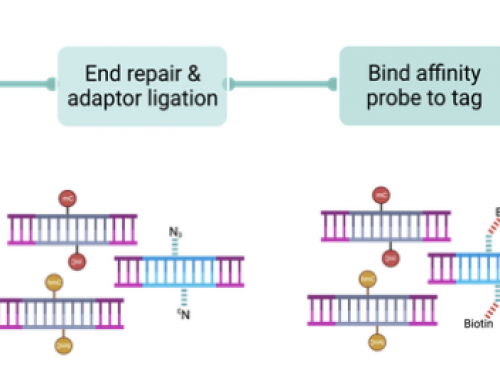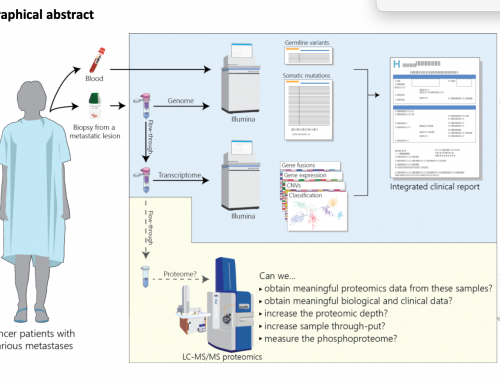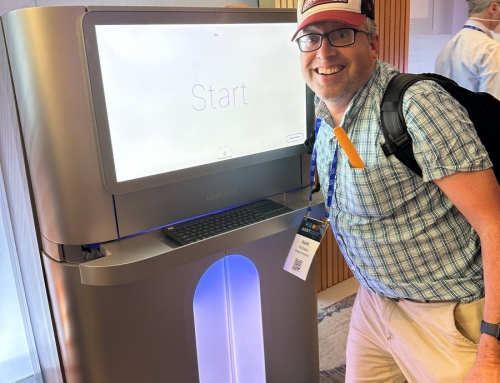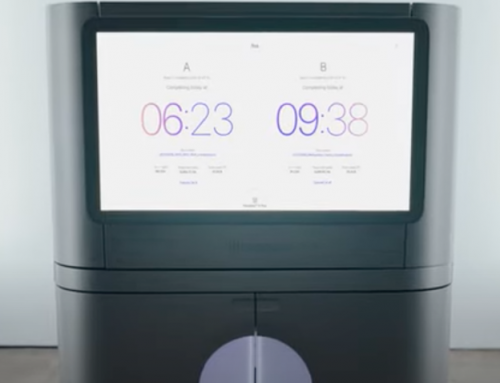Long-reads require long DNA molecules which require high molecular weight (and undamaged) DNA. Extraction with your standard column is unlikely to be optimal. I’m starting to look at the best methods for HMW DNA extraction for long-read applications as my lab is supporting a couple of pilot projects on the 10X Genomics phased genomes/exome technology, and we’re bringing the ONT MinION into my core lab as a new service offering this year.
The last time I was thinking about HMW DNA prep was almost 15-20 years ago. A group at JIC was part of the massive Wheat BAC cloning project and I was in the lab sharing the robotics for colony screening (I was making macro-arrays for “high-throughput” gene expression analysis – 1152 PCR amplicon spots).
Two recent blog posts caught my attention; the first from Nick Loman’s group in Birmingham describing the protocol used to generate 950kb reads on MinION, the second from the 10X Genomics blog “Meet Jill Herschleb” where Jill describes their protocol for fresh-frozen tissue that yields ~300 kb fragments. Neither of these preps use gel plugs!
There are many variables that will affect gDNA quality in sample types, including sample age, transportation methods, type of tissue, additives, freezing method, etc.
The Loman protocol:
The Quick Protocol, sounds faster than the now obsolete, Loman Protocol (sounds like a Joy Division album) is capable of generating incredibly large HMW DNA molecules with the record standing somewhere north of 900kb. It uses a modified Sambrook phenol-chloroform extraction/purification (read Cell: “Culinary Biology” a review of Maniatis from 1990 which says “the appendix is an unexpected joy…loaded with such gems as…the electronic mail address of the Japanese nucleotide sequence data bank”), with minimal pipetting steps. I used this same method for some huge DNA extraction protocols in 1997 when a research assistant at the JIC – it’s a real blast from the past.
- 5 x 10^7 human cells in a 50 ml Falcon tube (I’m unsure how much tumour tissue this equates too – please make suggestions in the comments)
- Mix in 10ml of TLB buffer (Tris, EDTA, a little SDS and RNaseA)
- Incubate at 50C for 3 hours (Nick suggests rotating the tube end over end, a tube roller might be gentler)
- Add the lot to a 50ml Phase-lock Gel tube and 10ml Phenol:Chloroform
- After phase separation the DNA is ammonium acetate + ethanol precipitated
- HMW DNA can then be “spooled” on a glass rod
Take care not to be harsh when handling the HMW DNA and the results are remarkable as attested to by Nick and Josh’s success.
@pathogenomenick @Clive_G_Brown @coregenomics @nanopore !! Soon 1 Mb will be routine….this is amazing.
— Mark Akeson (@AkesonUCSC) March 8, 2017
10X Genomics protocol:
A note of caution when reading Nick’s post (see above): the focus on MinION is on the number of molecules extracted. For 10X Genomics we need to ensure there are not too many molecules present as this messes with the expectations of what’s likely to be in a gel bead for molecular tagging.
Jill manages the 10x Genomics sample prep group (all the preps for Genome and Single-cell applications – she’s a good lady to know, follow her on Twitter @ScienceJill ). Her group have developed a HMW DNA extraction protocol for fresh-frozen tissue that is capable of generating ~300 kb fragments using magnetic bead extraction.
The 10X protocol describes extraction from fresh frozen breast tumour tissue so is immediately relevant to much of the work we’re doing in the CRUK Cambridge Institute. It does include a disclaimer that it’s not been tested with other tissues which may give sub-optimal DNA extraction e.g. liver, due to high enzyme activity.
The protocol says to handle the extraction”carefully” and suggests using a wide-bore pipette tips.
It was tested on two replicate fresh frozen breast tumour tissue samples, with two elution’s from each sample. PFGE analysis showed >150kb length HMW DNA and Chromium genome analysis returned mean DNA size of >80 kb, the highest sample quality defined in their Chromium Genome tech note.
- Start with around 25mg of tissue (0.5 cm3 so small biopsies are out)
- The protocol uses the Sigma PURE extraction kits (about £30 per sample)
- Nuclei are first isolated then digested with Proteinase K
- HMW DNA is then purified with SPRI Select (read my 2012 “How SPRI works” post – over 150,000 other people have!)
- Expect an average size of >150-200 kb by pulsed-field gel electrophoresis.

HMW extracted with the 10X Genomics protocol is >150Kb
I’ll be looking at other protocols in the next few months so if you have recommendations please do suggest them in the comments.
PS: compare and contrast the differences in DNA quality with the differences in production quality – Nick’s Google Doc versus 10X professionally designed PDF.








Thanks for posting, James! It’s so exciting that HMW DNA is leaving “niche” status and going mainstream. Its a great time to be a part of this community. 🙂
I am super excited to try NIck’s protocol! Techniques from the 80’s/90’s do tend to produce better DNA. Before the world caught SNP (and then short-read NGS) fever, DNA integrity was important for Southern Blotting, long-range PCR, etc.
Our group has lots (>15 years, gasp!) of experience with HMW DNA extraction, so if you or anyone else has questions like “how the heck do you work with viscous gloopy DNA?” just let me know! I could talk for days about this stuff.
Many thanks, Jill (@ScienceJill)
Hi Jill,
Do you think really long DNA will be a problem in the 10X droplets? If we can get MB long molecules into droplets then we might need fewer molecules in each droplet and I’m wondering what the impact on linked-read calling might be?
Hi James – So far we haven’t seen any problems with Linked-Read variant calling or de novo assembly. Pipetting the ultra-HMW DNA does cause some fragmentation.
So whether we start with 300 kb DNA (linked in your post) or 2 Mb DNA (we do this using dialysis), the final results after running Chromium Genome are very similar, with average DNA size ranging from 100 kb to 200 kb. This is likely not true for other tech like the minION where DNA molecules are handled less during the workflow, and therefore less fragmentation.
Hopefully one day we’ll find a trick to getting Mb molecules inside of GEMs! -Jill
I dont know if anyone could see this after 3 years, I have some problem in digesting my mouse genome prepared from spleen cells using the commercial kit which is based on salt precipitation method. i got viscous solution after o/n rehydration while the conc. is only around 500 ng/uL, these genomice DNA resist to enzyme restriction, leaving shining band in the loading well of agarose gel, making downstream southern blot difficult due to insufficient digestion. Any suggestion to help with my digestion? I don’t try sonication cause i have to measure the Telomere length at the end of each chrosome, the sonication will cause artificial result. But the HWM genomic DNA is hard to handle. Thanks
Thanks for covering our work James — but please all the credit must go to Josh Quick!
The new improved Quick protocol should point credit where it’s due!
Nice to see a protocol for HMW DNA extraction with SPRI beads like ours (cheaper) : http://www.biotechniques.com/BiotechniquesJournal/2016/October/Extraction-of-high-molecular-weight-genomic-DNA-for-long-read-sequencing-of-single-molecules/biotechniques-365135.html
Good idea to add a nuclei isolation step!
Hi Baptiste,
More and more people are going to be looking into HMW DNA extraction so you might get a few more citations!
Thanks for sharing.
[…] to genomic DNA, requires long-reads so are optimising Longboard protocol for WGS. Needs long DNA (see earlier post on DNA extraction). Questions: how long do reads need to be to get whole centromeres on all […]